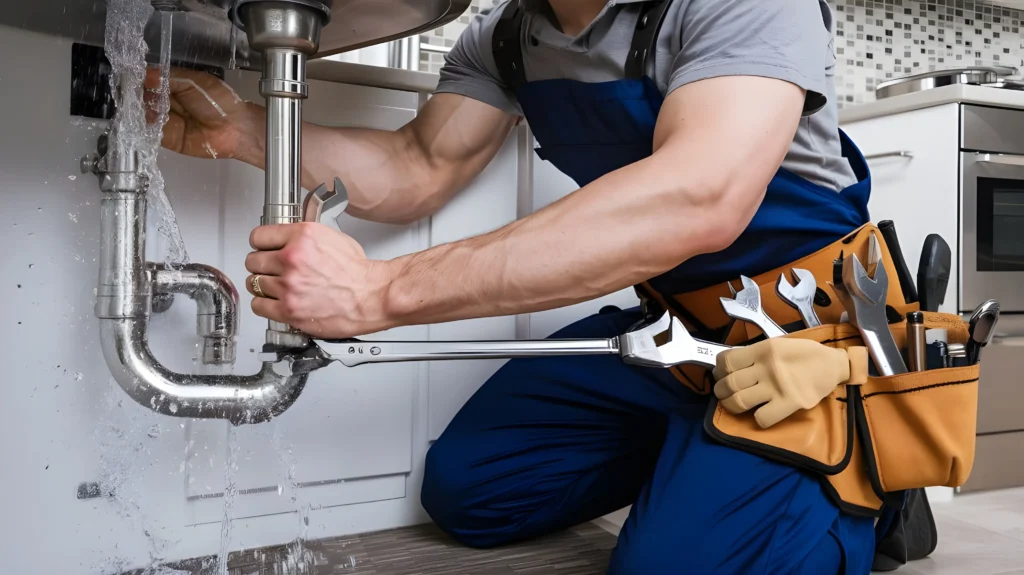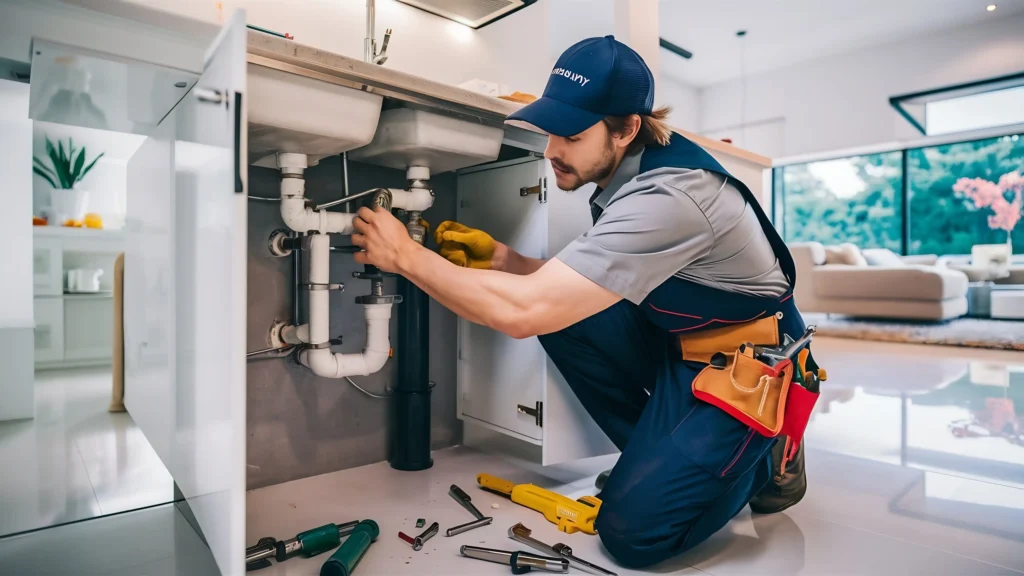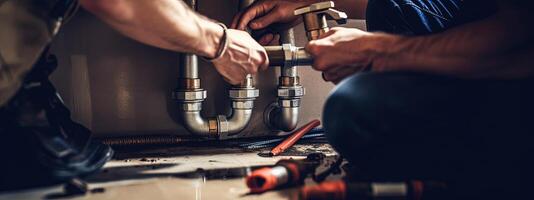A home’s plumbing skeleton during construction – every pipe location has been carefully planned to ensure the water flows exactly where it should. Imagine you’re building or renovating a cosy Orange home – perhaps a sleek new kitchen or bathroom amid the cool autumn air. You might dream of fixtures that make your place shine, but the last thing you want is water spurting where it shouldn’t. In Orange (NSW), new plumbing installations need more than muscle – they need a plan. Expert planning for New Plumbing Installations in Orange means a design that suits our local climate, meets all regulations, and avoids messy surprises (like burst pipes or council fines). It’s about sketching out exactly where each pipe, valve and fixture will go so that on move-in day you’re sipping tea, not mopping floors.
Modern Australian plumbing must also save water and energy. Professionals fit WELS‑rated, water‑saving fixtures and can design rainwater harvesting or greywater recycling systems. To understand WELS labels, star ratings and how they help you pick efficient taps, showers or toilets, check out the official Water Rating Australia – WELS Scheme Overview.

Expert Planning for New Plumbing Installations in Orange
When you work with plumbing professionals, they consider everything. Orange’s climate and local rules shape how plumbing should be done. Key factors experts cover include:
- Climate and Environment: Orange’s winters often dip near freezing. Expert planners know to insulate pipes and set plumbing paths that won’t freeze solid under the frost. (Ever had a mysterious cold tap in winter? A good plan prevents that.)
- Code Compliance: NSW law requires all plumbing work to meet the national Plumbing Code of Australia (PCA) standards. That means pipe sizes, slopes and materials must follow AS/NZS 3500. Plus, local councils (like Orange Council) demand that licensed plumbers do the job. Experts ensure your installation ticks every box, avoiding nasty council orders or fines.
- Efficiency & Sustainability: Modern Australian plumbing must also save water and energy. Professionals fit WELS-rated, water-saving fixtures and can design rainwater harvesting or greywater recycling systems. This means lower bills for you and a greener footprint for your home.
- Future-Proof Design: A sound plan doesn’t just solve today’s needs – it anticipates tomorrow’s. Good designers account for potential additions (extra bathrooms or laundries) so you won’t have to break through walls later. Thinking ahead spares you massive renovation headaches and expenses down the track.
- Quality Materials: Pro plumbers pick pipe materials that suit Orange’s conditions. For example, corrosion-resistant copper or flexible PEX tubing (great in cold weather) might be chosen for water lines. PVC or polyethylene drains handle waste. Choosing the right material up front means decades of reliable service instead of guesswork.
By checking all these boxes in advance, expert planning turns a potential plumbing headache into a smooth process. Now let’s break down the details:
Navigating Codes, Permits and Local Rules
Australian plumbing is heavily regulated, and for good reason: health, safety and durability. In NSW the Plumbing Code of Australia (PCA) is the rulebook. As the NSW Building Commission explains, “The PCA sets out the requirements for the design, construction, installation… of plumbing and drainage installations”. Essentially, every new pipe or fixture must comply with AS/NZS 3500 standards. These plumbing requirements are detailed in the National Construction Code (Volume Three: Plumbing Code of Australia), published by the Australian Building Codes Board—your go-to for regulations and compliance. For full details, check out the ABCB’s NCC on plumbing standards (Volume 3).
On a practical level, this means you can’t just start attaching pipes on a whim. Orange’s council (like all NSW councils) requires approvals before new water, sewer or stormwater work begins. Even minor jobs – say moving a sink or adding a tap – typically need a permit. And crucially, the law says only a licensed plumber can legally carry out this work.
Failure to follow these rules can be costly. Imagine pouring in years of materials and labour, only to get a stop-work notice because you lack the proper approvals. A professional planner will handle the paperwork: they submit the design to Orange City Council, arrange inspections, and ensure every stage is signed off. This keeps your project on track and avoids fines or being forced to undo completed work.
Designing a Reliable Plumbing System
With regulations sorted, the next step is design. Expert planning means figuring out exactly where each component goes: pipe runs, fixture locations, shut-off valves, drainage slopes – the whole network. It’s like drawing a plumbing roadmap.
Pipe Materials Comparison: To illustrate, here’s how pros think about common piping options in Orange:
| Material | Average Lifespan | Typical Use | Key Traits |
| Copper | 50+ years | Hot & cold water supply | Very durable and corrosion-resistant; handles heat; more expensive. |
| PEX (cross-linked polyethylene) | ~40 years | Indoor water lines | Flexible and easy to install; tolerates freezing better; affordable; color-coded options. |
| PVC (polyvinyl chloride) | 25–40 years | Drainage & cold water | Non-corrosive and lightweight; great for sewer/drains; cannot handle hot water. |
| Galvanized Steel | 40+ years | Older constructions (being phased out) | Strong but can corrode; largely replaced by copper/PEX in new installs. |
Every pipe type has pros and cons. For example, copper pipes (shown below) can last half a century, making them ideal for long-term reliability. PEX is a modern favorite in cold climates (it flexes slightly rather than burst if left to freeze). In your plan, a plumber will choose materials best suited to Orange’s water quality and your budget.
Close-up of a plumber carefully tightening a fitting on a new pipe. Proper tools and materials prevent leaks and ensure a tight, durable connection.
Layout-wise, the planner maps out:
- Supply lines: Where the water main enters, the meter is, and how it branches to every tap, shower, laundry and outdoor spigot.
- Drainage pipes: The size and slope of drains for kitchens, bathrooms and outdoor drains, ensuring gravity carries waste away without backup.
- Fixtures and valves: Exact placements of toilets, sinks, showers, water heaters, rainwater tanks, and the corresponding shut-off valves for each zone.
- Pressure concerns: Orange’s water pressure can vary; experts may include pressure-reducing valves or pumps in the plan to keep showers soothing rather than a disappointing trickle.
All this is sketched out before a single pipe is cut. The result: a clear blueprint. During construction, tradesfolk follow this roadmap, plugging right into the planned holes and connections. This foresight avoids awkward surprises (like a pipe intersecting with a wall stud or a hidden beam).
Why Thorough Planning Saves Money and Headaches
It might seem faster to skip detailed planning and just start nailing pipes in. But that’s like assembling flat-pack furniture without instructions – you might end up with leftover screws and a lopsided shelf. In plumbing, the consequences can be far worse (think leaks, floods, or code failures).
Here’s what good planning buys you:
- No Costly Rework: When everything is measured and foreseen, there’s no tearing up floors or walls to fix mistakes. For example, experts calculate pipe slopes precisely – this prevents blockages or sewage backup. Without that, you’d spend money fixing clogs and leaks later (and really, no one wants a backed-up sink or running toilet after move-in).
- Accurate Budgeting: A completed plan means solid quotes. You’ll know exactly how many meters of pipe, fittings and fixtures you need. This avoids last-minute ‘oh we need one more box of pipe’ surprises. Clear plans also make council inspections breeze through, so your build won’t stall with red tape (which can spiral costs).
- Time Savings: With no guesswork, installation proceeds smoothly. Trades aren’t waiting around to re-measure or clear up confusion on site. In Australia’s booming construction market, efficient scheduling keeps workers on task – a big plus if you want your new bathroom finished before family visits!
- Longevity and Peace of Mind: Plumbing is hidden, out of sight – so make it foolproof from the start. When pros install quality materials (like corrosion-resistant copper or UV-protected pipe for outdoors), you avoid constant maintenance later. A well-planned system typically needs fewer repairs, meaning less stress for you.
Put simply: an upfront investment in planning pays off enormously. As one expert notes, “Accommodating future needs at the initial stage can save considerable time, effort, and money”. In other words, designing smart the first time around prevents pouring even more time and cash down the drain.

Working with the Professionals
When you hire an experienced plumber or a hydraulic consultant in Orange, they bring both skill and local know-how. This collaboration is how planning turns into success:
- Site Assessment: The pro checks your property – water meter location, soil conditions (especially if you’re using a septic tank or soakage pit), and where sewer lines run. They note anything special, like existing roots or pipes, to plan around.
- Blueprint Creation: Armed with site data, they draft a plumbing diagram showing every pipe and fixture. You (and your builder) get a clear visual of the plumbing layout for the entire project.
- Material and Fixture Selection: Together you review options – from high-efficiency taps to large rainwater tanks. The plumber advises on what works best in Orange’s climate (for example, a frost-free yard tap or a water heater rated for our cooler weather).
- Approvals and Coordination: The plumber submits the plan for council approval and schedules inspections at key stages. They also coordinate with other trades (like electricians or tilers), ensuring plumbing doesn’t clash with other systems (for example, electrical insets or framing).
- Installation: Once approved, the plumbing crew follows the plan meticulously – cutting and joining pipes where indicated. They test pressure, flush lines, and check for leaks as they go. For instance, before walling in a new shower, they’ll conduct a pressure test to guarantee everything is sealed.
A licensed plumber consults the plumbing blueprint with a homeowner. Open communication and detailed planning upfront lead to a smooth installation.
By the end, you have not just pipes in walls, but a documented, tested system built to last. And if you ever sell your home, that certificate of compliance or well-documented plan is a selling point – buyers love knowing the plumbing is done right.
Common Pitfalls of Skipping Planning
Without expert planning, you might encounter:
- Pipes in the Wrong Place: Ever kicked a protruding pipe under a sink or banged your head on a shower faucet? A rushed job might ignore ergonomic placement. Good plans make sure faucets and valves are exactly where you want them.
- Hidden Leaks: Improperly sloped drains or loose fittings can cause slow leaks that hide behind walls, damaging floors over time. Planning includes pressure-testing pipes to catch these early.
- Fixture Shortages: Without a detailed list, you may run out of fittings mid-job, causing delays. Conversely, you might overbuy unnecessary parts. A pro plan nails inventory, saving cost and clutter.
- Code Violations: It’s easy to accidentally break a rule – for example, not installing an anti-backflow device where needed, or using the wrong pipe size. Fines or having to redo work are expensive setbacks.
- Water Inefficiency: Forgetting to specify water-saving taps or a rainwater tank in the design means wasted water and higher bills. In Orange, sustainable plumbing is not only environmentally smart, it’s often encouraged by incentives.
All these headaches are avoidable. The key is to treat new plumbing like a mini-engineering project, not an afterthought.
Conclusion and Next Steps
Building or upgrading plumbing in Orange is an exciting step toward a more comfortable home. But remember – the real magic happens during the planning stage. When you invest in smart design and expert insight from the beginning, New Plumbing Installations in Orange become smooth, stress-free, and future-proof.
By engaging professional expertise up front, you turn what could be a plumbing minefield into a clear, confident path. You’ll end up with a system that’s not just compliant, but reliable, efficient, and tailored to Orange’s unique climate. Plus, you’ll save time, money, and avoid those “why didn’t we think of that earlier?” moments.
So, before the first trench is dug or the first pipe is glued, grab a coffee and chat with your local plumber or hydraulic consultant. Get that blueprint drawn up, lock in your permits, and then watch your dream home take shape – leak-free and stress-free.
And hey – if you’ve got a burning plumbing question or a renovation tale to share, drop a comment below or pass this article along. We’re here to help you build smart and live dry!
Frequently Asked Questions
Do I need approval for a new plumbing installation in Orange?
Yes. In Orange (NSW), any new water, sewer or stormwater installation requires council approval, and by law it must be done by a licensed plumber. Even minor projects (like moving a sink) typically need authorization under NSW plumbing regulations. Plan for these permits early to avoid fines or costly rework.
Why should I hire a professional plumber for new installations?
A pro plumber saves you money and headaches. They ensure pipes are sized, sloped and installed to code (avoiding nasty leaks or sewer backups). They handle permits and know Orange’s local quirks (like frost protection). In short: you avoid DIY disasters and get a reliable, compliant system.
How does planning save time and money on new plumbing?
Proper planning minimizes costly rework and delays. A good design considers future expansions (so you don’t rip out walls later) and nails water flow from the get-go. It also means realistic quotes and smooth council approvals, so no surprise bills or hold-ups. In short: it saves time, stress and money.

